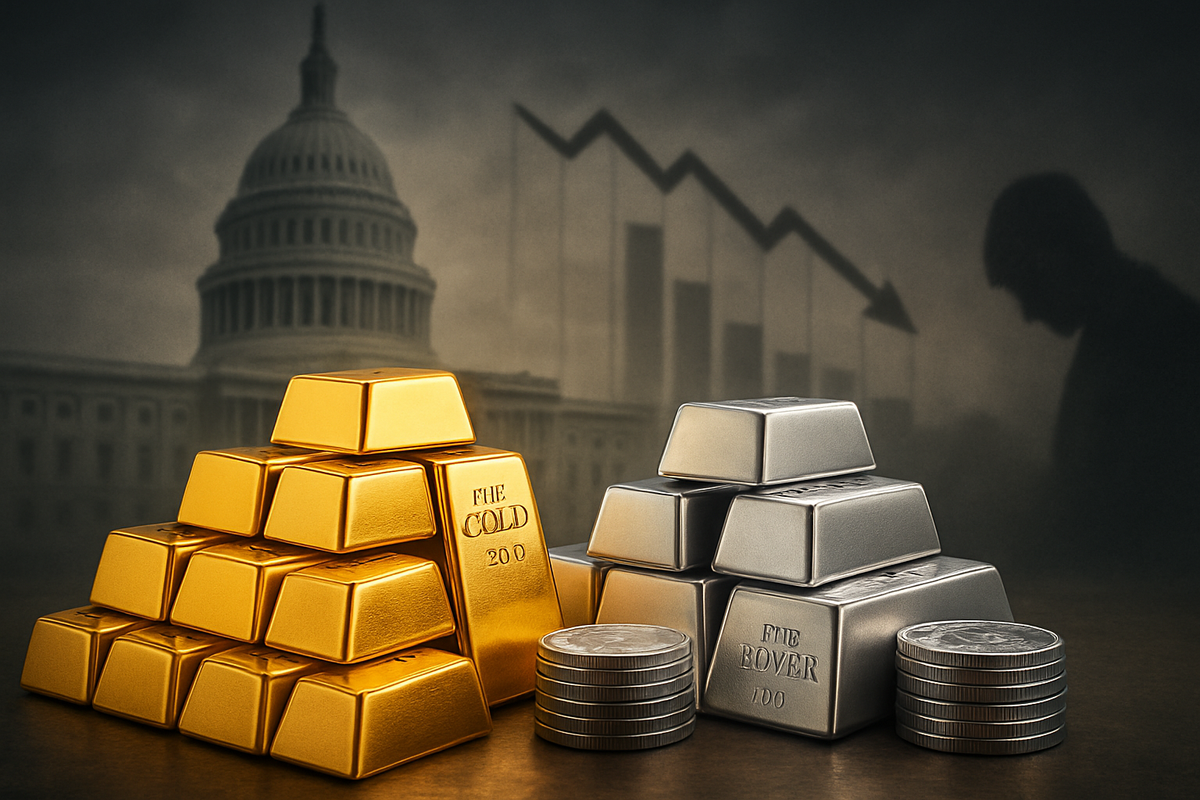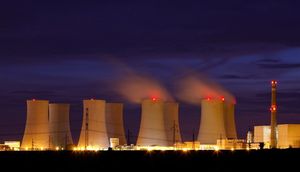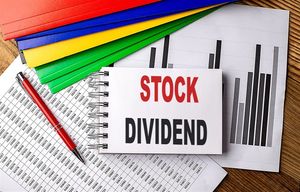
As the United States grapples with its longest government shutdown in history, precious metals gold and silver have experienced a significant rally, driven by a profound flight to safety among investors. The market's anxieties, exacerbated by plummeting consumer sentiment and persistent economic uncertainty, have propelled these traditional safe-haven assets to new highs. As of November 10, 2025, with the shutdown entering its second month, the immediate implications point to a market deeply unsettled by political gridlock and a deteriorating economic outlook.
The surge in gold and silver prices reflects a collective investor response to the twin pressures of an unresolved fiscal crisis and a populace losing faith in the economy. This environment has created fertile ground for precious metals, which historically thrive during periods of heightened risk and instability. The ongoing political developments in Washington, coupled with alarming signals from consumer confidence surveys, underscore a pervasive sense of unease that continues to shape market behavior and drive capital towards tangible assets.
Detailed Coverage: A Market Responds to Crisis
The current rally in gold and silver is a direct consequence of a confluence of critical events, most notably the protracted U.S. government shutdown, which commenced on October 1, 2025, and remains active as of November 10, 2025. This shutdown, now exceeding 40 days, has not only become the longest in American history but has also cast a long shadow over the nation's economic stability. While the Senate advanced a compromise bill on November 9, signaling a potential path to resolution, the measure still requires approval from the House and the President, meaning the uncertainty persists.
The economic fallout from the shutdown has been immediate and severe. Approximately 900,000 federal employees have been furloughed, with many more working without pay, leading to significant personal financial strain. Furthermore, the halt in federal data releases has obscured the true picture of the economy, adding another layer of ambiguity for investors. This disruption, combined with a weak jobs report, has intensified concerns about a broader economic slowdown, prompting a decisive shift towards safe-haven assets.
Adding to the market's woes is the dramatic decline in U.S. consumer sentiment. The University of Michigan's Consumer Sentiment Index for November 2025 plummeted to 50.3, a three-year low and nearing the all-time record low. This sharp drop is widely attributed to anxieties over job security, persistent inflationary pressures, and the direct impact of the government shutdown itself. Consumers across various demographics are expressing significant worries about the economy's future, indicating a broad-based erosion of confidence.
In response to these developments, gold briefly surpassed $4100 per ounce, and silver topped $50 per ounce on Monday, November 10. This robust performance is a classic "flight to safety," driven by the perceived stability of precious metals during times of macro uncertainty. The deteriorating fiscal outlook, even with a potential shutdown resolution, is also playing a role, as rising bond yields increasingly reflect fiscal unease rather than tighter monetary expectations. The market is clearly signaling its demand for assets that can weather political turmoil and economic headwinds.
Corporate Fortunes Shift Amidst Precious Metal Frenzy
The dramatic surge in gold and silver prices, catalyzed by the ongoing U.S. government shutdown and a widespread decline in consumer confidence, is creating a clear bifurcation in corporate fortunes across various sectors. Companies directly involved in the extraction, financing, or holding of precious metals are poised for substantial gains, while those reliant on these metals as raw materials or sensitive to discretionary consumer spending face significant headwinds.
The Winners: Miners, Streamers, and ETFs Shine Bright
At the forefront of the beneficiaries are gold and silver mining companies. Higher precious metal prices directly translate into increased revenues and expanded profit margins for these producers. Companies with efficient operations and low production costs are experiencing a magnified positive impact. Leading the charge are major gold miners such as Newmont Corporation (NYSE: NEM), Barrick Gold Corporation (NYSE: GOLD), and Agnico Eagle Mines Limited (NYSE: AEM), all of which see their profitability soar with each upward tick in gold prices. Similarly, silver-focused producers like Fresnillo plc (LSE: FRES), the world's leading silver miner, Pan American Silver Corp. (NASDAQ: PAAS), and First Majestic Silver (NYSE: AG) are reaping substantial rewards, especially given silver's dual role as a safe-haven and an industrial metal. Other notable beneficiaries include Kinross Gold Corporation (NYSE: KGC), Coeur Mining, Inc. (NYSE: CDE), Americas Gold and Silver (NYSE: USA), and MAG Silver (NYSE: MAG), which are all well-positioned to capitalize on the rally.
Precious metals streaming and royalty companies also stand to gain significantly. These firms, which provide upfront financing to miners in exchange for future production at fixed, low costs, benefit from rising commodity prices without incurring the direct operational risks of mining. Franco-Nevada Corporation (NYSE: FNV), Wheaton Precious Metals Corp. (NYSE: WPM), and Royal Gold, Inc. (NASDAQ: RGLD) are prime examples, leveraging their diversified portfolios to capture value from the appreciating metals. Royal Gold, for instance, recently reported record quarterly revenue and operating cash flow, directly attributable to higher average realized prices for gold and silver.
For investors seeking direct exposure, physically backed precious metal Exchange-Traded Funds (ETFs) are also clear winners. Funds like SPDR Gold Trust (NYSE Arca: GLD) and iShares Silver Trust (NYSE Arca: SLV) directly track the prices of their underlying commodities, providing a convenient way for investors to participate in the rally. Additionally, VanEck Gold Miners ETF (NYSE Arca: GDX) and Global X Silver Miners ETF (NYSE Arca: SIL) offer broader exposure to the mining sector, reflecting the overall bullish sentiment.
The Losers: Jewelry, Tech, and Discretionary Spending Under Pressure
Conversely, several industries face considerable headwinds. Jewelry retailers and manufacturers are experiencing significant challenges. Soaring gold and silver prices directly increase their raw material costs, making it difficult to maintain profit margins. With poor consumer sentiment and economic uncertainty, passing these increased costs onto consumers becomes a formidable task, likely leading to reduced sales volumes. While specific major players weren't highlighted as "losers" in the research, the entire sector, particularly smaller retailers and those with thin margins, will struggle.
Industries heavily reliant on silver as an industrial input, such as electronics, electric vehicle (EV), and green technology manufacturers, are also feeling the pinch. Silver's critical role in components like solar panels, circuit boards, and EV batteries means that its rising price directly inflates production costs. Companies in these sectors, unless adequately hedged, will face margin compression and potentially higher product pricing.
Finally, the broader economic impact of poor consumer sentiment and a prolonged government shutdown negatively affects consumer discretionary companies. A reduction in overall consumer spending for non-essential goods and services will impact sectors like retail, automotive, and hospitality, leading to decreased revenue and compressed profit margins across a wide range of public companies.
Wider Significance: A Bellwether for Global Economic Unease
The current surge in gold and silver prices, set against the backdrop of an unprecedented U.S. government shutdown and deeply pessimistic consumer sentiment, transcends a mere market reaction; it serves as a potent bellwether for broader global economic anxieties. This rally underscores the enduring role of precious metals as safe havens, while simultaneously highlighting significant shifts in industry trends, potential ripple effects across various sectors, critical policy implications, and compelling historical parallels.
This event is firmly rooted in a broader, sustained bullish trend for precious metals that has been gaining momentum since the early 2000s. Factors such as escalating global debt, speculative market bubbles, and perceived failures in monetary policy have consistently driven investors towards tangible assets. The current environment, marked by geopolitical risks and concerns over currency debasement, positions this rally as potentially entering a "third phase" characterized by widespread institutional and retail adoption. A crucial aspect of this trend is the aggressive accumulation of gold by central banks globally, particularly in emerging markets. This strategic pivot towards tangible assets, often seen as a de-dollarization effort, signals a fundamental recognition of political risks inherent in traditional reserve assets and challenges the long-standing dominance of the U.S. dollar.
The ripple effects of this precious metals surge are extensive. For precious metals mining companies like Barrick Gold Corp. (NYSE: GOLD) and Newmont Corporation (NYSE: NEM), expanded profit margins and stronger cash flows are enabling debt reduction, increased exploration, and enhanced shareholder returns, making them attractive investment propositions. Conversely, the prioritization of precious metals can draw investment away from other commodities, leading to divergent performance within the broader commodities market. Financial institutions and investment vehicles, particularly Exchange-Traded Funds (ETFs) such as SPDR Gold Shares (NYSE Arca: GLD) and iShares Silver Trust (NYSE Arca: SLV), are experiencing massive inflows, validating the robust investor demand for precious metals exposure. This "risk-off" sentiment also signals a lack of confidence in traditional dollar-denominated assets, potentially impacting growth-oriented sectors that thrive on market stability.
From a regulatory and policy standpoint, the current economic climate presents unique challenges. The weak U.S. economic data, including job losses and declining consumer confidence directly attributable to the shutdown, is fueling expectations for potential Federal Reserve interest rate cuts in December. Lower rates typically enhance the appeal of non-yielding assets like gold and silver. Furthermore, even a resolution to the shutdown will likely redirect market focus to the deteriorating U.S. fiscal outlook. Rising bond yields are increasingly reflecting fiscal unease rather than purely monetary expectations, a dynamic that historically supports investment in precious metals. Concerns about policy inconsistency and debt sustainability, potentially exacerbated by proposals like a "tariff dividend" alongside a significant budget deficit, further bolster the appeal of these safe havens. Globally, the trend of central banks diversifying away from dollar-dominated holdings reflects fundamental concerns about currency stability and the need for assets without counterparty risk.
Historically, gold and silver have consistently demonstrated their resilience during periods of economic and political instability. During the 2008 financial crisis, gold showed remarkable resilience, while silver often outperforms gold during times of geopolitical and financial uncertainty, as seen during the 2023 banking crisis. U.S. government shutdowns have also historically impacted gold prices; the 35-day shutdown from 2018-2019, for example, saw gold gain approximately 6%, reflecting the unprecedented length and accompanying economic uncertainty. The current hypothetical shutdown, described as the longest in history, aligns with conditions that historically support sustained gold rallies. Comparisons to past gold bull markets of the 1970s and 2001-2011 reveal shared drivers, including fiscal deficits, currency concerns, and geopolitical risk. While the current rally's magnitude may differ, some analysts suggest it is still in its early stages. A distinguishing feature of the current rally is the unprecedented pace of central bank purchases, indicating a more systemic shift in global financial strategy.
What Comes Next: Navigating the Precious Metals Landscape
The significant rally in gold and silver, propelled by the ongoing U.S. government shutdown and deeply entrenched poor consumer sentiment, sets the stage for a dynamic and potentially transformative period for precious metals. As of November 10, 2025, the market is grappling with profound economic uncertainty, geopolitical complexities, and shifting monetary policies, all of which underscore the enduring appeal of tangible assets in both the short and long term.
Short-Term Trajectories and Key Catalysts:
In the immediate future, spanning late 2025 into early 2026, gold and silver prices are expected to remain volatile but with a strong upside bias. Gold, having recently corrected from record highs above $4,380 in mid-October, is consolidating around $4,000-$4,080 per ounce, with potential to retest $4,100-$4,200 if it maintains support above $4,040. Silver, which has demonstrated even more aggressive performance with a 73.7% year-to-date gain and a recent peak of $54.47, is currently hovering near $49-$50 per ounce, eyeing a breakthrough of the $50.00 threshold towards $50.60-$52.00. The impending resolution of the U.S. government shutdown, while potentially tempering some immediate safe-haven demand, is unlikely to fully alleviate concerns about the nation's fiscal health and burgeoning debt, thus continuing to provide underlying support for precious metals. Crucially, the high probability of a Federal Reserve interest rate cut in December, driven by weak economic data and slowing growth, is expected to further bolster gold and silver by weakening the dollar and lowering real yields. Silver's inclusion on the U.S. critical minerals list and its growing demand from clean energy sectors also provide robust structural support.
Long-Term Outlook: New Horizons for Precious Metals:
Looking beyond 2026, the long-term outlook for gold remains exceptionally robust. Several prominent institutions, including Goldman Sachs, project gold could reach $5,000 per ounce by 2026 if current conditions persist. Saxo Bank suggests gold could approach $5,000 and silver $65 within the next 12 months, while JP Morgan forecasts significantly higher average levels for gold through 2026. The World Gold Council also anticipates an upward trajectory over the next 18 months, with silver expected to maintain its strength. This sustained bullishness will be underpinned by persistent inflation, ongoing currency devaluation risks, mounting fiscal deficits, and enduring geopolitical tensions. The continued strategic diversification of foreign exchange reserves by central banks, particularly in emerging markets, away from the dollar towards gold, will provide a sustained and fundamental demand floor. Aggressive predictions even suggest silver could surpass $100 per ounce in the medium term, driven by its unique combination of industrial applications and safe-haven appeal.
Strategic Adaptations and Market Dynamics:
In this evolving landscape, strategic portfolio diversification remains paramount, with precious metals serving as a critical hedge against economic uncertainty, inflation, and geopolitical risks. Experts recommend a strategic allocation, suggesting gold for stability and silver for tactical plays, especially during cycles of high industrial demand. Investors must vigilantly monitor macroeconomic data, particularly Federal Reserve communications and the eventual release of delayed economic figures post-shutdown, to anticipate policy shifts. Hedging strategies, such as utilizing options on gold and silver, can offer greater flexibility amidst elevated volatility.
Market opportunities are abundant, driven by sustained safe-haven demand, a weakening U.S. dollar, anticipated monetary easing, structural central bank demand, and the growing industrial applications for silver. However, challenges persist, including inherent price volatility, the potential for a temporary pullback upon a definitive shutdown resolution, the risk of a stronger U.S. dollar or an unexpected hawkish Fed pivot, and a robust global economic recovery that could shift sentiment towards riskier assets. Potential scenarios range from a continued bullish rally, pushing gold towards $5,000 and silver towards $60 or even $100, to a consolidation phase with moderate growth, or a less likely bearish correction if global economic conditions stabilize significantly. The current environment strongly favors continued interest and potential appreciation in gold and silver, cementing their role as essential safe-haven and store-of-value assets in uncertain times.
Comprehensive Wrap-Up: Enduring Appeal in Turbulent Times
The significant rally in gold and silver prices, inextricably linked to the prolonged U.S. government shutdown and a pervasive decline in consumer sentiment, represents more than a fleeting market anomaly. It is a profound signal of deep-seated economic anxieties and a strategic recalibration of investment portfolios in response to unprecedented political and financial instability. As of November 10, 2025, the narrative is clear: precious metals are reclaiming their historical role as indispensable safe havens.
The key takeaways from this event are multifaceted. Firstly, the market's immediate reaction underscores the severe impact of political gridlock on economic confidence. The longest U.S. government shutdown in history, coupled with near-record low consumer sentiment, has created a fertile environment for a "flight to safety." Secondly, the rally highlights the enduring and even growing appeal of gold and silver as hedges against inflation, currency debasement, and geopolitical risks, an appeal further bolstered by aggressive central bank accumulation and expectations of Federal Reserve rate cuts. Thirdly, the event has created a clear divergence in corporate performance, with precious metals miners and associated investment vehicles experiencing significant gains, while industries reliant on these metals as inputs or sensitive to discretionary consumer spending face considerable challenges.
Moving forward, the market is likely to remain highly sensitive to developments surrounding the U.S. fiscal situation and global monetary policy. While a resolution to the government shutdown might induce temporary profit-taking in precious metals, the underlying concerns about U.S. debt and economic fragility are expected to persist, providing continued fundamental support. The anticipated weakening of the U.S. dollar and the prospect of lower interest rates will further enhance the attractiveness of non-yielding assets like gold and silver. Moreover, silver's dual role as both a monetary and an increasingly vital industrial metal, particularly in the burgeoning clean energy sector, positions it for potentially aggressive growth.
Investors should closely watch for several key indicators in the coming months. These include the progress and eventual terms of the government shutdown resolution, any shifts in the Federal Reserve's monetary policy stance, and the release of delayed economic data, which will offer clearer insights into the health of the U.S. economy. Geopolitical developments and the continued trend of central bank gold purchases will also be critical barometers. In an environment defined by uncertainty, gold and silver are poised to maintain their significance as essential components of a diversified portfolio, offering both a store of value and a potential for substantial capital appreciation. Their current rally is not just a reaction to immediate crises but a testament to their lasting importance in a world seeking stability amidst turbulence.
This content is intended for informational purposes only and is not financial advice







